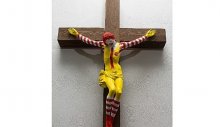
This has been a dark week for Christians.
A controversial art exhibition at the Haifa Museum of Art in Israel has caused quite a stir. One piece on exhibit is a statue of Jesus on a cross painted in such a way that it looks like Ronald McDonald.
The reactions of Christians have been shameful and lamentable.
I first heard of this story when a distant family member forwarded an impassioned message to me which tried to rally Christians to boycott McDonald's, because they refused to condemn the artwork.
Soon, Christians in Haifa were holding demonstrations, causing injury to people in the process. Clearly, Christians were angry and indignant.
Christians feel marginalised, because they feel that other religions, like Judaism or Islam, would not be subjected to this kind of ridicule.
The protests got the attention of the mayor of Haifa, who said that the piece should be removed from public display. The museum says that the mayor does not have authority to dictate which pieces of art it exhibits. Cries of censorship and laughter at Christians' rage fill corners of the Internet.
Every Christian should be in deep mourning. They should not be mourning that a mockery was made of a statue of their Saviour. Who are we to feel indignation on the part of Jesus? This is the same Jesus who, when being arrested without good cause, prevented His disciples from committing violence and telling them
Or do you think that I couldn't ask my Father, and he would even now send me more than twelve legions of angels?
Matthew 26:53
How pathetic, miserable, and misplaced are our attempts at defending the honour and holiness of the King of all Creation!
The cross is not a religious symbol. It is not a holy relic or sacred icon. The cross is a tool of capital punishment in a most brutal way. People hung on a cross were done so with the express purpose of humiliating them, as they hung there naked and defecating themselves as their bodies slowly lost the ability to perform even the most basic functions, until they could not even breathe any longer. The cross was meant to inflict maximum pain, discomfort and humiliation, and to loudly proclaim that such is the fate of those who oppose the mighty Roman Empire.
The red stripes on Jesus's body, not unlike those of the Ronald McDonald on the cross, were not painted on: they formed from His blood running down His arms and legs. His hair—like Ronald's—was red with His own blood. His body wasn't yellow, but blue and red from the bruises caused by brutal beatings and scourging. If He had but had some paint dabbed on Him, that would have been a much easier humiliation for Him to bear!
The point is that the purpose of the cross was so that Jesus would be humiliated and shamed unto death. What pictures and statues of Jesus are subjected to today do not compare to what He had to endure physically. And while Jesus does reign in glory today, this world is still under the dominion of sin and darkness, and the world would just as soon crucify Him again if they were given the chance. That should not surprise and shock us. That should be what we expect.
Jesus does not need our outrage and indignation. He demands that we show love and forgiveness. Our response should not be anger, threats and violence. Instead, we should speak—use this opportunity to begin a conversation about Jesus. Speak to non-Christians about Jesus's humiliation on the cross and why He subjected Himself to it. Listen to what other people say and respond in a way which is compassionate, not threatening. Learn to differentiate between a symbol and the actual person of Jesus. Lament and weep that there are people who would wish to humiliate Jesus instead of desiring His compassionate embrace. Pray for their salvation. And praise God that today the cross and the tomb are both empty!
Let a man mercifully correct what he can. Let him patiently bear what he cannot correct. And let him groan and sorrow over it with love.
Cyprian, bishop of Carthage
- . Photo credit: Haifa Museum of Art.







Latest comments